
The exact date which Emley AFC was formed is not known exactly. There is evidence of an Emley Football Club in 1884, but this is thought to have been a Rugby Football Club.

In 1903 Emley Clarence FC was formed and joined the Huddersfield League. It is from this club that the current club is descended.
For the first 66 years of its existence the club played in local junior leagues around Huddersfield. They were successful from time to time as the list of honours at junior level illustrates. However it was not until the 1960’s that Emley started to make a noticeable impact in national non-league football.

By the mid-sixties, Emley were the best non-league team in the Huddersfield District, thanks to a rich crop of local players.
This crop included men who were to go on to give a great deal to the club in its rise up the non-league ladder – Michael Pamment, Roger Wood, Ian Kettlewell, Granville Ellam and Melvyn Matley – all Emley-ers -are the ones who stand out.

The committee at that time took the forward looking decision to enter the FA Amateur Cup. At that time this was the leading national competition for purely amateur teams. Emley first entered in 1968-69 and did amazingly well, whilst still a junior side, playing in the Huddersfield District League, they reached the last sixteen.

This first taste of the big time led the Emley committee to take the big step of applying to join the Yorkshire League, which was then the senior amateur league in the area, with a long and proud tradition of providing strong and competitive football. This was a bold step for the club to take. It meant a big commitment, since traveling was much wider than in the Huddersfield League. Emley is only a small place (around 1800 people) and there must have been some doubt as to whether the place could sustain Senior Non-League football.
To give the team the best possible chance, Harry Fearnley, ex-Huddersfield Town Goalkeeper was appointed manager. The playing strength was however still very-much locally based, most of the players coming from the village itself.

This first season however saw Emley’s first senior honour when they won the Yorkshire League Cup, beating Rawmarsh Welfare after a replay at Stocksbridge.
The following season Emley finally got justice when they were promoted to the First Division of the Yorkshire League.

With Senior status the club also had chance to enter the FA Cup, and when the Amateur Cup was ended in 1974 due to the creeping influence of Semi-Professionalism, Emley entered the more senior of the non-league knock-out competitions, the FA Trophy. It was to be some years before Emley made their mark in either of these cups.
Former Huddersfield Town winger, Kevin McHale had taken over as manager at the start of the season, and this signalled a period of great success for the club. Over the next seven seasons Emley won the Yorkshire League Championship four times and were runners-up the other three seasons. In addition they won the Yorkshire League cup three times, and the Sheffield Cup twice more.
This period cemented Emley as a non-league force in Yorkshire and brought the club into contact with other major forces in non-league football. In particular during the 1979-80 season Emley reached the first round proper of the FA Trophy for the first time and traveled to Blyth Spartans. Blyth were a well known at the time following their recent successes in the FA Cup. Emley were unlucky not to win at Blyth, but got a draw only to lose the replay 4-2.
Behind the scenes the fabric of the club had been developed, with a strong committee, including men who had served the club for decades, both as players and officials. Alec Hardy went on to be Chairman for a total of 47 years, Eric Moorhouse was President for 13 Years, and Gordon Adamson secretary for 36 Years.

In 1981-82 Emley did the clean sweep in the Yorkshire League, winning the League and Cup Double, and the Reserve Division League and Cup Double. In addition the Reserves won the Huddersfield Invitation Cup.
However, moves were afoot behind the scenes to merge the Yorkshire League with the stronger Midland League to form the Northern Counties East League, made up of teams from Yorkshire, Lincolnshire, Nottinghamshire, Derbyshire and Leicestershire. Five clubs were invited from the Yorkshire League, including Emley. Another fifteen from the Midland League made up the Premier Division of twenty clubs. This meant eight more games a season for Emley since the Yorkshire League First Division had only sixteen clubs.
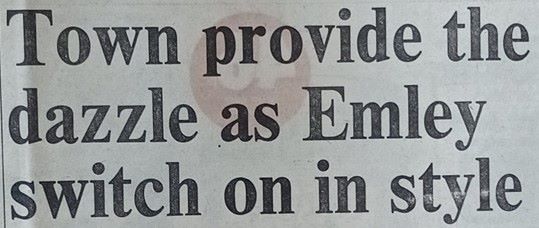
Emley had added floodlights to their facilities in 1981, when these were quite rare for non-league clubs at this level. This paid off when floodlights became compulsory for clubs in the NCE Premier Division. At first the going was tough as the Midland League clubs were generally stronger than those in the Yorkshire League. Emley had been used to only having three or four serious rivals for the championship. Initially in the NCE League Emley were a mid-table side.

Michael Pamment, who had played on and off for 16 years for the club, and scored a record 305 goals, had taken over as manager in 1978, and served until 1985. His reign saw Emley build a strong side in the more competitive league, and the club managed a third place and a later a runners up spot in 1985-86. Also in this time Emley entered the FA Vase rather than the trophy. This is the lesser of the two non-league cup competitions, but gave Emley a real chance of reaching Wembley.

The first real prospect of this came in 1986-87. Emley were challenging for the League, League Cup, Sheffield Cup, and most importantly in terms of prestige the Vase. After some tough battles in the earlier rounds, including a bruising encounter against Rossendale from Lancashire, and a visit from Dawlish Town from Devon, Emley played St. Helens Town in the Semi-Final. Willy Carpenter scored the only goal in the first (away) leg, and Wembley looked a definite prospect, but with 8 minutes remaining in the second leg St Helens equalised, then missed a penalty. In extra-time they were the stronger side and scored to go 2-1 up on aggregate. Emley then also missed a penalty and the dream was put on hold.

The disappointment was so great, Emley’s form collapsed and the club won nothing, losing in the semi-final of the League Cup, the final of the Sheffield Cup and finishing well out of contention in the league.
The following season however Emley came back with a vengeance. The manager was now Gerry Quinn, who astutely put a very well balanced side together, containing some quality non-league players. The team were drawn away in every round of the Vase, but this did not prove an obstacle. The run contained some memorable games against sides such as Bridgnorth Town (beaten 6-0 after a 3-3 draw), Gresley Rovers and Durham City.

The semi-final was against Bashley of the Wessex League. After a 1-1 draw in the away leg, Emley could not be complacent at home. The second leg was played in a gale force wind, and John Francis, who was to go on to a long professional career with Sheffield United and Burnley, scoring the all important goal to take Emley to Wembley.
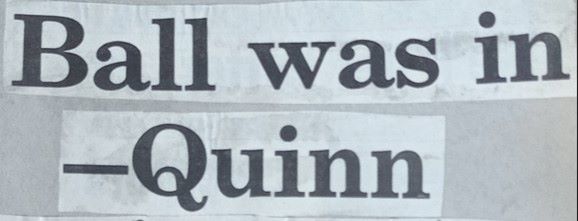
10,000 fans made the journey to the world centre of football on 23rd April 1988. another 5000 came to cheer Colne Dynamoes from Lancashire. Colne were very much an up and coming non-league club, built and financed by their manager Graham White, a millionaire. The match was a very tight affair, Emley had a good claim for a goal turned down following a corner in the first half, but though Emley had the better of the match, no goals were forthcoming in normal time. In extra time Colne got the vital strike as both teams tried. Despite some frantic efforts from Emley, they could not equalise, and we tasted defeat under the twin-towers.

Emley also won the league that season, Colne won the North-West Counties and were to go on to win the Northern Premier League, before White disbanded the club in disappointment at not being accepted into the Conference, due to their ground not being big enough.
In 1988 Emley had ground grading problems of their own. Having won the league in a tense last match against North Ferriby in front of 1200 people (a NCE record), drawing 2-2 after being 2-0 up and coasting with ten minutes left, Emley thought they would be promoted to the newly formed Northern Premier League First Division. However the NPL increased their ground grading requirements during the season and Emley, though plans were in place to make the necessary improvements, had no chance to implement them in time.

This disappointment focused minds at the club the following season. The ground improvements were made, including new dressing rooms, and a 200 seater stand. Equally importantly, the league was won again, this time more comfortably. In the Vase Emley gained revenge on a very good Colne side, winning 2-1 at Colne in a memorable match. The Colne side included Alan Kennedy who scored the winner in a European Cup Final for Liverpool, but Mick Farrar gave Emley the win with a late goal. Sadly Emley could not reach Wembley again, going out to Rossendale in a later round.
The 1988-89 season also saw Emley win the Sheffield Cup for the fifth time, but now it was into the nineties and the Northern Premier League.

Emley’s first match in the higher echelons of non-league football was at Winsford. After the disappointment of rejection for ground grading reasons in 1988, it was something of a shock to go to Winsford, playing in a run-down greyhound stadium, which was not a patch on Emley’s ground as a place to play football. This theme was to go on, as Emley realised that half the teams in the league would struggle to reach the grading standards if they had to reapply for membership.
A 3-0 defeat also made the management realise that it was going to be tough to do well in this league. But they soon got to grips with the challenge and Emley finished a creditable 5th in their first season.
Emley’s last crack at the Vase sadly ended in defeat at Rushden, now a top Conference side. The following season it was back to the Trophy as Emley were now regarded as too highly placed for the Vase.
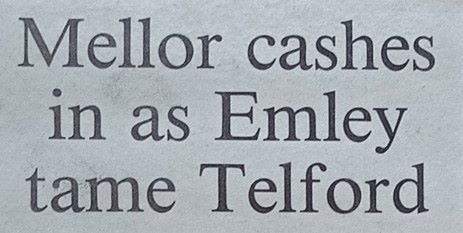
However the Trophy was to give Emley another dose of cup glory. After beating Northern Premier League Premier Division sides Southport and Morecambe in the qualifying rounds, Emley visited Telford of the Conference in the First Round proper. A nil-nil draw in Telford gave Emley a home chance in the replay, and a Reg Mellor goal was enough for a win in a tough, tight game. The second round saw Hyde United dispatched. They were not pleased however with the referee when he allowed an Emley winner in the last minute, and he required an escort from the pitch as angry Hyde players, officials and supporters berated him.

This brought on Kettering Town in the Third Round at Emley. Kettering were a very strong non-league side at the time. They were top of the conference and looking likely to go into the Football League. A Kettering goal in the first minute looked ominous, but Emley didn’t let their heads drop. A crowd of 2726 supporters, saw Emley fight back in the second half. Chris Wood equalised and Graham Broadbent incredibly gave Emley the lead with 8 minutes left. This was a memorable goal, Broadbent hitting a vicious dipping shot from 25 yards.
Kettering too had fight and equalised four minutes from time, and a replay looked likely. However Emley’s captain Codd had other ideas, and he produced near hysteria, when he smashed the ball home for a 3-2 victory in the last minute.
Emley had reached the quarter-finals of the Trophy for the first time, but could go no further. Kidderminster Harriers, another Conference side, proving too strong at their own ground, to win 3-0.

In the league however, Emley had managed to stay involved, despite the distraction of the Trophy. As the end of the season approached, they were in contention with Whitley Bay, Accrington Stanley and Worksop Town for the two promotion places. Emley had to produce a good run in their last five games, to be played over two weeks, to ensure promotion. They duly won all of them, without conceding a goal, and scoring 14, including a 1-0 victory over eventual champions Whitley Bay, to snatch the runners-up slot ahead of Worksop Town.
Up until 1991, Emley had never been further than the Third Qualifying Round of the most prestigious domestic cup competition in the world, the FA Cup. Success in this competition was the only way a non-league club could get national recognition, even reaching the Vase final at Wembley was virtually ignored in the national media. Finally, in this first year in the Northern Premier League Premier Division, Emley managed to reach the fourth qualifying round, and dreams of a league club in the First Round Proper.
Chorley stood in the way and it took three tense games to decide. In the first only a last gasp goal from Broadbent saved Emley after Chorley took the lead with a penalty. The replay at Emley was also drawn. In the second replay back at Chorley Mally Wright gave Emley the lead just after half-time to set-up one of the most tense 45 minutes in the club’s history as Bolton Wanderers awaited the winners. Emley held out to meet probably the most glamorous team available in the third and fourth divisions. Bolton had won the cup three times, albeit in the dim and distant past.

The match was played at Huddersfield Town’ Leeds Road ground in front of 9035 people, more than Town had got for their first round match. Unfortunately Emley couldn’t pull off an upset, losing 3-0, despite giving their all. Bolton, mid-way up the third division and destined for greater things in coming years, proved too strong.

Emley won the Sheffield Cup for the seventh time and finished respectably in the league, but what looked like a basis for further development was destroyed when Gerry Quinn left in the summer to take over struggling Altrincham. He took the most influential players in the squad with him, despite assurances to the contrary, meaning a man to whom the club owed a lot and who would have been welcome forever at the club, had he behaved more honourably, became persona non-grata, until a partial reconciliation in 1998.
Steve Codd, the inspirational captain took over, but found himself with a massive rebuilding job to do, with very weak foundations on which to build. The remainder of the successful Quinn side broke up and Codd had to make the best of the situation. Sadly this proved beyond him and Emley struggled over the next three seasons, finishing in the bottom half of the league with hardly a sniff of silverware to be found.
Eventually he was dismissed, this was again a sad ending for a man who gave so much to the club. Mick Pamment took over as caretaker and steadied things until Ronnie Glavin, formerly of Celtic and Scotland, and revered for his time at Barnsley took over.
Glavin astutely rebuilt the side, using his many contacts in the game to attract players to an unfashionable club. These players were a mixture of ex-professionals, with still something to give to the game, players rejected by professional clubs with a point to prove, and local players whom he brought the best out of.
Another good Trophy run in 1996-97 was only ended by Conference side Kidderminster (again!) after a 0-0 draw and the same season the club finished fourth in the NPL Premier Division, their highest position ever.

1997-98 will go down as Emley’s greatest year (to date). Emley finally broke through to national attention in the FA Cup. After a courageous win at Nuneaton in front of 2000 hostile fans (3-2) Emley were disappointed with the draw away at Morecambe, which looked a very tough match with little chance of victory, making any money, or of being noticed. However Emley fought back from 1-0 down to draw 1-1, then in a remarkable replay won on penalties 3-1, after a 3-3 draw. Emley looked dead and buried when 3-2 down with a minute of extra-time to go, until Gary Marshall popped up to equalise.

The second round was the furthest Emley had ever been in the competition and Lincoln City, top of the Third Division (away again!) looked like proving the climax of the run. Again Emley went a goal down, but fought back to get 2-1 up. The victory seemed inevitable as injury time ticked into its seventh minute. But Lincoln equalised and it seemed Emley’s chance was gone.

The disappointment was immense, especially when the Third Round draw was made – West Ham United, eighth in the Premier league awaited the winners. The replay was played at Huddersfield Town’s new stadium – the McAlpine, and Emley fans hearts sank when Lincoln went 2-0 up with 20 minutes to go. But this team proved just how gutsy and determined they were to pull it back to 2-2 with just a few minutes remaining. The drama continued into extra-time, Emley went 3-2 up but Lincoln equalised to force penalties again. Marples in the Emley goal proved the hero again, saving the last penalty to give Emley a 4-3 win and cup glory.

The attention Emley got for this win and the visit to West Ham was beyond the clubs wildest dreams. Major features in all the national papers, on the national news and breakfast television, journalists from the News of the World on the team bus, interviews on Sky and Football Focus, Team of the Day on Match of the Day following highlights of certainly the finest performance in the club’s history. These are things that any follower of a club as small as Emley can only dream of and will be almost impossible to surpass.
This 1997-98 season was rounded off with the club’s eighth Sheffield Cup win against Parkgate at Hillsborough, giving the club its first trophy for six years. This match was sadly marred by a fight between Simon Jones and Neil Lacey after the final whistle, which resulted in the sacking of Jones after six years service. This could not detract however from this teams magnificent achievements over the season, which also saw the club finish sixth in the NPL.

After the highs of the previous season 1998-99 was always likely to be an anti-climax. There were good cup runs again. In the FA Cup Emley reached the first round and met Rotherham United. The home game was played at Oakwell in front of over 6,000 spectators. Emley dominated the first half and scored through Bambrook, but Rotherham were relieved to get an equaliser 8 minutes from time to force a replay.

The replay at Millmoor started well when Bambrook scored in the first minute. But this brought a fierce response from the Millers who bombarded Emley and eventually ran out 3-1 winners. The departure of Bambrook back to local football, the loss of Nicholson through injury in the first Rotherham game and Reynolds’ transfer to Ayr United for £60000 seriously affected Emley’s form in the second half of the season. They battled through to the FA Trophy Quarter-Finals however, including a fine away win at Guiseley, only to go out tamely to eventual Conference Champions Cheltenham Town, 1-0 at home.
The cup runs in the two major cup competitions, compounded by the burden of injuries and suspensions on a small squad severely affected Emley’s league form, and 13th place was all that could be achieved. In the Sheffield Cup, Emley were defeated in the final by a solitary goal by Stocksbridge Park Steels and so a season that promised much ended in disappointment. The Sheffield Cup final also saw the retirement of Ian Banks, an ex-pro who never gave the impression he was above the non-league game, and who’s skills from dead-ball situations provided many vital goals in the four seasons he was at the club.
The last season of the old millennium turned out to be mediocre by recent standards. It started brightly enough, with Emley heading the Unibond Premier division for a time and progressing in both the FA Cup and Trophy. The Cup run ended at home to Southport in a replay after a fine battling away performance. Though there was some controversy in the defeat, Emley can have no complaints, being outplayed for most of the game. The same opponents ended the Trophy run. Emley reached the final of the Sheffield Cup but were thrashed by Frickley after an poor performance, and finished 5th in the league. However the season will mainly be remembered for what happened when it ended.
Rumours had been circulating that the powers that be at Emley were looking to leave the village. This was prompted by looming changes to Unibond regulations on Ground Grading. For some inexplicable reasons, the ground that had been perfectly adequate for nearly 100 years for a village club averaging 350 people per game was deemed no longer up to standard. The central issue concerned three-sided grounds. Amongst others, that meant Emley would be thrown out of the league unless they spent vast, unwarranted amounts to upgrade. The Club had been unable to expand the ground anyway due to local pressures, and there was no way that it would ever reach Conference standards. Added to this, a loss of £50,000 due to ever increasing wage bills, and little prospect of dramatically increasing the gate, the ambitious club officials decided to look for a ground elsewhere.
At first, a share in a new ground with rugby league team Wakefield Wildcats to be built near Ossett. Then the club played a couple of games at Wakefield’s existing Belle Vue ground to test the water. These weren’t particularly successful, raising gates of 500 and 200. There seemed to be little interest in football at this level in the rugby town of Wakefield. A stormy AGM debated the move amongst much acrimony between the officials and long-standing club members who were against it. The vote was carried and an agreement made to play all first team games at Belle Vue in 2000-01

Initially things went well in Wakefield. In the first season there, Emley missed promotion to the Conference by a whisker. Amassing 100 points but finishing second to Stalybridge. The killer blow was a 3-2 defeat in Emley’s penultimate match at home to Stalybridge, when a bumper 3,708 were at Belle Vue to see Stalybridge claim victory with a stoppage-time goal. In the following season Emley sustained their challenge for the league, but could only finish fifth. They again reached the Sheffield Cup Final and again lost, this time to 3–0 Doncaster Rovers at Hillsborough. In the close season the club decided to rename itself Wakefield & Emley FC.
This alienated many of the village and other long standing supporters as the club frequently began to be referred to as simply “Wakefield”. A dire season followed in 2003–04 with a bottom place finish of the Northern Premier League Premier Division. However, Emley were not related due to the re-organisation of the English non-league pyramid that saw the creation of the Conference North and South leagues.The club changed its name once again in the 2004–05 season, this time to Wakefield–Emley. They finished mid-table this time.
After 2005, Wakefield–Emley continued at Belle-Vue, but they were relegated to the Northern Premier League First Division. In 2006, all connections to the old Emley were severed – changing the name to Wakefield FC and a move away from the traditional club colours and badge. At the same time, the Northern Counties East League disbanded its reserve division. The Wakefield-Emley reserves had continued in that division when the first team were promoted to the NPL and also continued to play at the Welfare Ground in Emley. This was the final straw. So, to keep the name of Emley alive and keep football playing in Emley, there was a split and a successor club was formed in Emley.
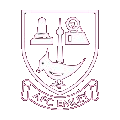
It was christened AFC Emley to establish itself as a distinct from the ‘old’ club who would soon drop the Emley part of their name entirely and become Wakefield FC. The new era at Emley started out in the West Yorkshire League where they performed well in Division One, just missing out on the title in their first season. Wakefield had allowed the Welfare Ground to go into decline following their move and what money the Club had went into the remedial work needed to get back into the FA pyramid. Luckily for the Club the FA carried out a re-organisation of the pyramid at the end of the 2006 season and the investments paid off as Emley were elevated into the Northern Counties East Division One.
The first few seasons were difficult as limited finances in a tough league saw a number of mid-table finishes and some frustration with the lack of progress up the league. The appointment of Darren Hepworth as manager, brought a glimmer of previous success with a run to the 4th round of the FA Vase. This included a memorable 3-1 away victory at Barnoldswick Town along the way. This was followed by a 7th place finish in the league.
There followed two successive ‘oh-so-nearly’ promotion pushes. Firstly, losing out on sudden death penalties in a play-off final in 2016 at Bottesford. Emley took a 1-0 lead only to concede a penalty in the last few seconds of normal time. In the penalty shoot out, Emley were 2 penalties to the good, only to miss their last three to hand Bottesford promotion. That season also included the headline grabbing scoring exploits of Ashley Flynn with 73 goals (it would have been 78 but for the expunging of one team’s record).
An even better season followed in 2016-17 reaching 95 points but missing out on promotion on goal difference and the league title by one point. The disappointment carried through to an unsuccessful play-off bid.
Following two season of mid-table finishes, the summer of 2019 saw major developments. The club reclaimed its old name of Emley AFC and a new management team was installed – Richard Tracey joined as Manager with Steve Nicholson, who played in the famous West Ham team, as his assistant. The club was also moved to the North-West Counties League, much to the surprise of everyone at the Club and many outside it.
Emley embraced the move; the team was rebuilt and was very well placed for promotion when the Covid-19 pandemic caused the termination and voiding of the season by the FA.
The disappointment was tempered to some extent by a move back to the NCEL for 2020-21. The management team strengthened the squad and got off to a great start, winning 8 and drawing the other two of the first 10 games. However Coronavirus again terminated the season early and it looked like all efforts were in vain for a second time.
But, the FA decided to forge ahead with the re-organisation it had postponed from the previous season, and promoted clubs based on Points Per Game over the two truncated seasons. This placed Emley second in the NCEL Division One and meant promotion to the Premier Division
The season in NCEL Premier Division was a tough one. After losing some key experienced players, Emley got off to an indifferent start. Results did pick up as Tracey and Nicholson strengthened the squad, but a run of one win in 13 games saw Emley flirt with relegation. However this was followed by a run of 8 wins in 9 to finish a creditable 9th in the league.
The 2022-23 season saw Emley improve further and a runners-up spot in the league, which would have meant a play-off for promotion, was a real possibility until defeat at Hallam in the penultimate league game meant Emley had to settle for a very creditable third place. A cup run to the semi-final of the League Cup was surpassed by Emley winning their first senior trophy for 25 years with victory over Maltby Main in the Sheffield Cup at Doncaster.

